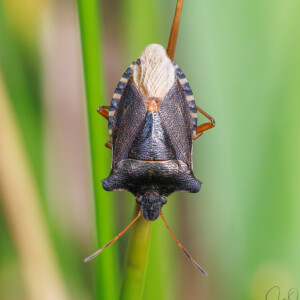Belly up
You rarely see the ventral side of a shieldbug, presumably because it's more vulnerable than the dorsal side - though in his excellent book Shieldbugs Richard Jones says this:
"At rest the more delicate hind wings are furled away and covered by the tougher protective layer of the partly overlapping front wings. Together with the large toughened upper front plate of the thorax (the pronotum), this gives the 'het' bugs (as they are sometimes known) a more solid, robust form than many of the Homoptera. Their under-bodies also tend to be tougher and harder."
He then goes on to explain that the cuticle is made up of chitin, a polysaccharide that's analogous to the cellulose that supports plant cell walls, which is laid down in thin sheets made up of parallel fibres. Multiple sheets are layered on top of each other, with the grain running in slightly different directions in each layer to increase the strength of the whole structure (as happens with plywood). The chitin fibres and sheets are impregnated and bound together by protein fibres, to create a tough but flexible surface. He goes on to say: "All insects use chitin, but in some hard and tough insects (het bugs are a very good example) the chitin layers are laid down so thickly that they achieve real armour-plating strength."
Nonetheless, shieldbugs are wary creatures, unsurprisingly given their position in the food chain, and they don't care for being approached. This one would probably have flown away as I stuck a macro lens in its face, but for the fact that it had chosen to perch on a soft rush in our wildlife pond, which didn't provide a good base for a take-off. The pond was semi-shaded at the time, so I would guess that the bug was also quite cold, and lacked confidence in its flight muscles. So it did the only thing it could think of to do, and put the rush between itself and my camera - probably not helpful, had I been an actual predator, but good for my purposes because it gave me an unusual photo.
In case you hadn't worked out its identity already, my second photo shows the more recognisable, dorsal surface of this Red-legged Shieldbug (sometimes called a Forest Bug), Pentatoma rufipes.
R: C5, D8.


Comments
Sign in or get an account to comment.


